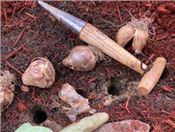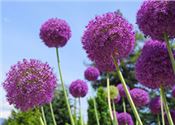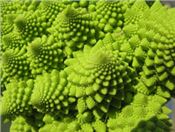Garden Page

LITTLE ROCK, ARK.
Tips for Indoor plants
• To prepare tropical plants (including houseplants) for the move indoors, begin to reduce the amount of light on them by moving them to a less sunny area now and then to full shade by mid-October.
• Before bringing houseplants back inside inspect closely for insect pests such as aphids, spider mites, scale, and whitefly. Treat or dispose of infested plants to protect other houseplants.
• Houseplants should be brought indoors at least one month before the heat is normally turned on.
• Prune back rampant growth and protruding roots.
• You can get last year’s poinsettia to flower by placing it in total uninterrupted darkness for 15 hours a day, starting the last week of the month and continuing until colored bracts appear. Give them plenty of sunlight during the day and fertilize every other week with a soluble houseplant fertilizer until bracts begin showing color.
• In November reduce or eliminate fertilizing houseplants until spring.
Tips for Planting Bulbs
Alliums add a pop of color to the late season flower bed. You may be most familiar with the June blooming giant alliums, Allium Giganteum, but there are others varieties worth checking out.
• Local garden centers start carrying spring flowering bulbs in September. Plant them now except tulips.
• Tulips should be kept in a cool, dark place and planted in late October or November. When planted sooner they will often grow and sprout to the surface this fall.
• As you shop the bulb aisle this fall, check out the alliums. Nearly all alliums, particularly those with large bulbs, grow best in free- draining soil. If you have wet clay, you’ll have to create a raised bed or amend the existing soil with loads of organic matter to improve drainage.
• Mix a balanced fertilizer into the planting soil and set the bulbs three times the depth of the bulb width.
• Mulch the area and be prepared to cover the bulbs with some type of wire mesh material if voles and squirrels have been a problem in the past.
• For best results, plant bulbs in a sunny spot, in well-drained soil.
How do I plant bulbs?
In the South, plant spring bulbs no sooner than late Oct. and early Nov. The soil temp needs to be between 40-60 degrees. To prevent rot, plant in well-drained soil. For extra fertilization, add a tsp. of bone meal to the bottom of each hole.
Choose a site with good drainage – especially in the winter. Standing water and bulbs are not a good combination. When planting bulbs, grouping them together in clusters will make a stronger impact than a single row of bulbs.
When planting your bulbs, you can dig individual holes for each bulb (which can be difficult in our rocky soils) or mass plant. It is often easier to dig up a larger planting area, scatter your bulbs in, and then fill the soil back in.
A general rule of planting depth is to plant two to three times the size of the bulb, deep in the ground. Small bulbs are planted shallow, while big bulbs need a deeper hole. You can even layer different bulbs in the same planting area. ∆

Try Some Edgy Veggies For A Groovy Garden This Year
COLUMBIA, MO.
“Create some interest in your garden patch by adding unique vegetables this spring”, said University of Missouri Extension horticulturist David Trinklein.
“One of the joys of gardening is trying something new each year,” Trinklein said. Less common vegetables can challenge your gardening skills and tease your taste buds. They also can disappoint, so center your garden on tried-and-true favorites, he says.
Salad lovers have several robust choices to liven up the taste and eye appeal of garden greens. The deep red, veined leaves of radicchio, also known as Italian chicory, make salads pop with contrast and color. Radicchio’s slightly bitter taste intensifies when the season grows hotter. Start very early for a spring crop or grow as a fall crop so that its small heads can mature while it is still cool.
Otherwise, it has the same cultural requirements as lettuce.
Some plants are the “fast food” of salad gardening because they can be picked about six weeks after seeding. Arugula, also known as roquette or garden rocket, adds a spicy, peppery taste to salads.
However, arugula is more than just another pretty face in the garden.
Its high fiber, antioxidants and glucosinolates offers many health benefits.
Other quick growers include Malabar spinach and an upland cress called peppergrass, or curled cress. Malabar spinach, or basella, produces greens similar in appearance to spinach. It tastes like mild Swiss chard. Unlike spinach, it tolerates heat and produces throughout the summer. This climbing vine grows up to 6 feet on a trellis. Start seeds indoors or plant outdoors after the danger of frost passes.
Raw or cooked, peppergrass leaves offer a pleasant, spicy flavor. A member of the cabbage family, it grows best in cool weather. Its small plantlets – microgreens – offer nutrients and flavor only 10 days after planting.
Romanesco’s chartreuse green buds look like something an extraterrestrial gardener may have left behind to delight earthly gardeners. The unusual appearance comes from its “self-similar”
growth habit. In other words, the whole is the same shape as its smaller parts. Its smaller buds, or curds, are arranged in a logarithmic spiral. Closely related to broccoli and cauliflower, it prefers cool growing conditions. Its crunchy edible buds have a delicate, nutty flavor.
These vegetables may foil in the soil
“Some unusual vegetables may not live up to their names and, unless the gardener knows what to expect, may be disappointing,” said Trinklein.
One such example is the vine peach. This vining plant, related to melons and cucumbers, produces fruits about the size of a peach with a light orange color. “However, they are nothing like a peach in flavor,” said Trinklein. “Vine peach is not good when consumed for fresh eating but is useful for making preserves, marmalades and chutneys.” You might say it is the pits for eating fresh.
Gardeners also may sour when planting lemon cucumber. The cucumbers from this plant are about the size of a lemon and develop a yellow color. Their flavor, however, it that of a cucumber – making it a lemon for lemon lovers. ∆

Romanesco is related to broccoli and cauliflower.
Photo by Jacopo Werther.